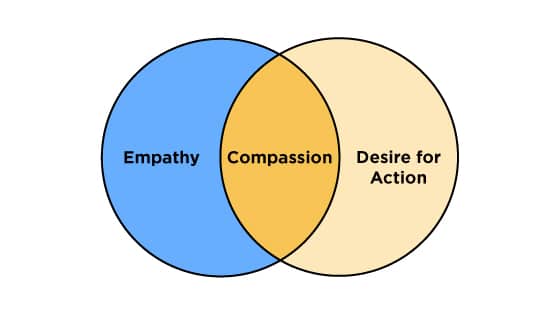DevOps is about people. About how to enable them to collaborate efficiently, let them contribute their specific skills to a multi-disciplinary team, let them share their knowledge, and let them use their unique experiences to accomplish the company’s goals.

Empathy is often touted as a go-to behavior to help teams collaborate. And sure, empathy definitely helps with cross-team respect, communication, acceptance of organizational complexity and breakdown of silos.
Empathy is a good way to build trust and safety within a team, and it helps to smooth out the kinks in partnerships between teams, especially as people make mistakes that hurt other teams. And even for building a strong culture within a single team, empathy is a must.
Empathy creates a sense of community and charity, and people have an innate sense to help others.
The opportunity cost of empathy Link to heading
However, there is a dark side to empathy.
Empathy is like a floodlight, shining a narrow light onto a small group or individual. By definition, by being empathetic to someone, you’re ignoring someone else: there is an opportunity cost to empathy. As the giver of empathy, you simply can’t put yourself in the shoes of ALL others; empathy is a hopelessly limited emotion.
For any one individual, there’s only so much empathy to have for others. In the context of a sufficiently large organization, it implicitly also means there are people that fall by the wayside. And by being empathic to some, and not to others, people exhibit non-DevOps-y behavior: it widens the gap between some individuals and teams, unintentionally creating silos.
 What’s the opportunity cost of empathy?
What’s the opportunity cost of empathy?
In other words: empathy creates silos, leading to us versus them thinking. People love that sense of belonging, to belong to a group. Naturally, they’re skeptical and even xenophobic of others outside of their group. Highly empathic people are usually more vengeful, and able to dehumanize their ‘enemies’ more.
Now, I’m not arguing to not have empathy at all, but I do want to caution you to be selective and aware of the opportunity cost.
Politics and Empathy are not a good mix Link to heading
Because in any sizeable organization, strong local empathy (i.e., highly empathic teams), are naturally inclined to create and think in silos, which at a global, organizational, level turns people against each other. That leads to toxic work environments, badly performing teams, individuals leaving your organization, etc.
And this is why the right culture, and specifically management and leadership culture are crucial. Without the right cultural balance between empathy, vulnerable leadership and team performance, things get poisonous quickly.

Some mixes are good. Others aren’t
(Coincidentally, this is also why DevOps-transitions usually fail once they reach the leadership level. Once you reach the upper-middle management echelons in the organization, empathy and vulnerability are super hard to ‘do’ right, and cause more harm than they do good.)
So, what do we need? Link to heading
When we look at optimizing performance across a larger section of an organization, we need to favor global optimization in lieu of local optimization. That still means team leads and team members need to practice empathy towards their own team members and direct stakeholders. Empathy is good, but only in moderation.
But culturally, it’s important to learn organizations to have compassion, not empathy. Compassion is more neutral, and more importantly, more constructive than empathy. It’s more scalable and less isolating. It helps teams balance their own interests with those of other teams, but is realistic in prioritization. Compassion helps align and drive multiple teams, instead of polarizing between teams.
Compassion is actionable, more solution-oriented. Compassion helps teams to see the wider issue and solve the issues at hand as efficiently as possible. Compassion is the right tool for organization-wide optimization.
Compassion requires vulnerability Link to heading
But being compassionate is not easy. It’s a combination of empathy-adjacent emotions, plus rational thinking and decision-making to help people out. It requires training to do right.

Empathy + Desire for Action = Compassion
There’s two parts to learning compassion:
Rational understanding of others. Compassion isn’t a purely emotional endeavor. Compassion is the rational understanding of other people’s situations, and feeling wanting to relieve their issues for them. This rational understanding and motivation to help them solve their issues is like a muscle that can be trained, by learning to zoom out, by putting things into perspective, and by adding rational understanding to feelings of empathy.
Rationally understanding others is a matter of putting things into perspective. Spend time thinking about, and talking to, those others. Zoom out. Try to rationally understand why they do what they do, what drives them, and what their goals are. Understand, rationally, that they have goals that conflict with your goals. Accept that any sizable organization is inherently complex, with conflicting interests, and no way of completely removing those conflicts. Try to understand the specifics of those goals, and solve the friction that comes from them.
The second ingredient is making it easier for others to be compassionate towards you, an important skill for people in leadership roles. Compassionate leaders have learned to open up, to be vulnerable, and to be brave. Take a look at Brené Brown if you want to learn more about vulnerability and courage. The crux is, that in showing their own doubts, emotions and struggles, they allow others to see them fully, which makes it easier for others to be compassionate. By not hiding parts of their personality, they invite others to show more of themselves. This makes it easier to rationally think about others, prevents dehumanization and decreases psychological distance.
Putting Compassion into practice Link to heading
Successful organizations train their leadership’s compassion. They train them to see the full extent of reality with all its limitations, to understand the messiness of conflicting interests in any organization, develop rational thinking skills and coach them to be courageous, learning them to show their full personality, remove their armor, be trustworthy, and act in alignment with their values. It also requires the organization to create a cultural system so that leaders can unfold their compassion fully. These practices range from simple time management so there actually is time to talk to others, to training and coaching.
Lastly, there’s nothing stopping you from putting this into practice. Being compassionate is free, and often well-received. You can just practice being compassionate throughout your day. A simple reminder is enough to think about and talk to those others, trying to rationally understand them, and offering your solution and help.
Go out there, show yourself, and be compassionate. I would appreciate a friendly note on Twitter if you do!
Further Reading Link to heading
If you’re interested in a similar topic, here is a presentation I did a few years ago on the subject of Impostor Syndrome. View the video, or read my blog post with a little more info.